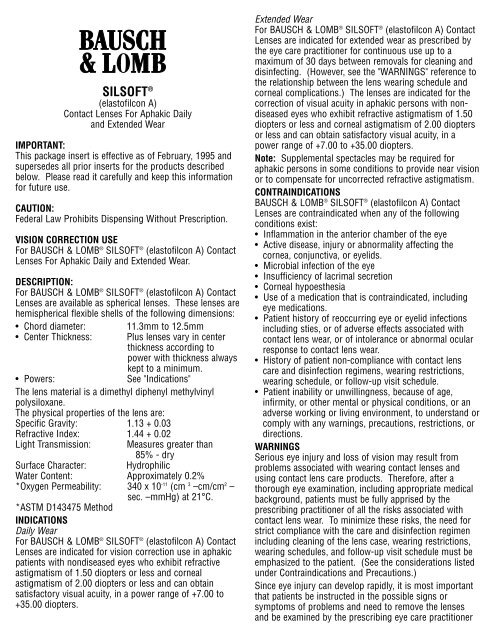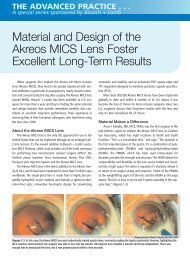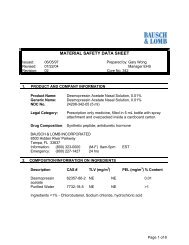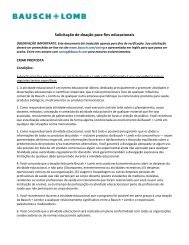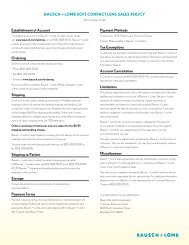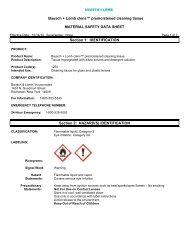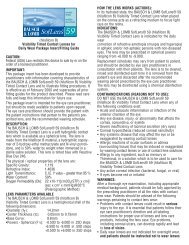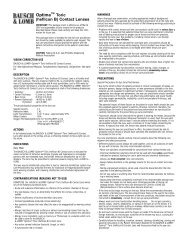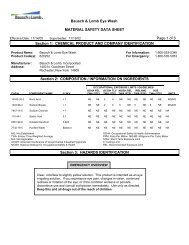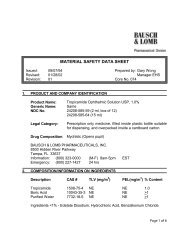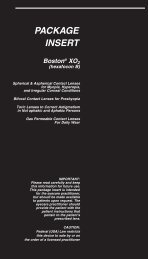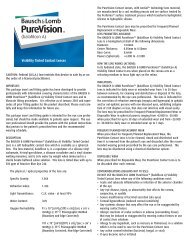SILSOFT® - Bausch + Lomb
SILSOFT® - Bausch + Lomb
SILSOFT® - Bausch + Lomb
You also want an ePaper? Increase the reach of your titles
YUMPU automatically turns print PDFs into web optimized ePapers that Google loves.
SILSOFT ®<br />
(elastofilcon A)<br />
Contact Lenses For Aphakic Daily<br />
and Extended Wear<br />
IMPORTANT:<br />
This package insert is effective as of February, 1995 and<br />
supersedes all prior inserts for the products described<br />
below. Please read it carefully and keep this information<br />
for future use.<br />
CAUTION:<br />
Federal Law Prohibits Dispensing Without Prescription.<br />
VISION CORRECTION USE<br />
For BAUSCH & LOMB ® SILSOFT ® (elastofilcon A) Contact<br />
Lenses For Aphakic Daily and Extended Wear.<br />
DESCRIPTION:<br />
For BAUSCH & LOMB ® SILSOFT ® (elastofilcon A) Contact<br />
Lenses are available as spherical lenses. These lenses are<br />
hemispherical flexible shells of the following dimensions:<br />
• Chord diameter: 11.3mm to 12.5mm<br />
• Center Thickness: Plus lenses vary in center<br />
thickness according to<br />
power with thickness always<br />
kept to a minimum.<br />
• Powers: See "Indications"<br />
The lens material is a dimethyl diphenyl methylvinyl<br />
polysiloxane.<br />
The physical properties of the lens are:<br />
Specific Gravity: 1.13 + 0.03<br />
Refractive Index: 1.44 + 0.02<br />
Light Transmission: Measures greater than<br />
85% - dry<br />
Surface Character: Hydrophilic<br />
Water Content: Approximately 0.2%<br />
*Oxygen Permeability: 340 x 10 -11 (cm 3 –cm/cm 2 –<br />
sec. –mmHg) at 21°C.<br />
*ASTM D143475 Method<br />
INDICATIONS<br />
Daily Wear<br />
For BAUSCH & LOMB ® SILSOFT ® (elastofilcon A) Contact<br />
Lenses are indicated for vision correction use in aphakic<br />
patients with nondiseased eyes who exhibit refractive<br />
astigmatism of 1.50 diopters or less and corneal<br />
astigmatism of 2.00 diopters or less and can obtain<br />
satisfactory visual acuity, in a power range of +7.00 to<br />
+35.00 diopters.<br />
Extended Wear<br />
For BAUSCH & LOMB ® SILSOFT ® (elastofilcon A) Contact<br />
Lenses are indicated for extended wear as prescribed by<br />
the eye care practitioner for continuous use up to a<br />
maximum of 30 days between removals for cleaning and<br />
disinfecting. (However, see the "WARNINGS" reference to<br />
the relationship between the lens wearing schedule and<br />
corneal complications.) The lenses are indicated for the<br />
correction of visual acuity in aphakic persons with nondiseased<br />
eyes who exhibit refractive astigmatism of 1.50<br />
diopters or less and corneal astigmatism of 2.00 diopters<br />
or less and can obtain satisfactory visual acuity, in a<br />
power range of +7.00 to +35.00 diopters.<br />
Note: Supplemental spectacles may be required for<br />
aphakic persons in some conditions to provide near vision<br />
or to compensate for uncorrected refractive astigmatism.<br />
CONTRAINDICATIONS<br />
BAUSCH & LOMB ® SILSOFT ® (elastofilcon A) Contact<br />
Lenses are contraindicated when any of the following<br />
conditions exist:<br />
• Inflammation in the anterior chamber of the eye<br />
• Active disease, injury or abnormality affecting the<br />
cornea, conjunctiva, or eyelids.<br />
• Microbial infection of the eye<br />
• Insufficiency of lacrimal secretion<br />
• Corneal hypoesthesia<br />
• Use of a medication that is contraindicated, including<br />
eye medications.<br />
• Patient history of reoccurring eye or eyelid infections<br />
including sties, or of adverse effects associated with<br />
contact lens wear, or of intolerance or abnormal ocular<br />
response to contact lens wear.<br />
• History of patient non-compliance with contact lens<br />
care and disinfection regimens, wearing restrictions,<br />
wearing schedule, or follow-up visit schedule.<br />
• Patient inability or unwillingness, because of age,<br />
infirmity, or other mental or physical conditions, or an<br />
adverse working or living environment, to understand or<br />
comply with any warnings, precautions, restrictions, or<br />
directions.<br />
WARNINGS<br />
Serious eye injury and loss of vision may result from<br />
problems associated with wearing contact lenses and<br />
using contact lens care products. Therefore, after a<br />
thorough eye examination, including appropriate medical<br />
background, patients must be fully apprised by the<br />
prescribing practitioner of all the risks associated with<br />
contact lens wear. To minimize these risks, the need for<br />
strict compliance with the care and disinfection regimen<br />
including cleaning of the lens case, wearing restrictions,<br />
wearing schedules, and follow-up visit schedule must be<br />
emphasized to the patient. (See the considerations listed<br />
under Contraindications and Precautions.)<br />
Since eye injury can develop rapidly, it is most important<br />
that patients be instructed in the possible signs or<br />
symptoms of problems and need to remove the lenses<br />
and be examined by the prescribing eye care practitioner
or a corneal specialist immediately if they experience any<br />
symptoms such as those listed below under Adverse<br />
Effects. (Practitioners examining patients presenting such<br />
symptoms should see below Important Treatment<br />
Information for Adverse Effects.)<br />
Extended Wear: The risk of ulcerative keratitis has been<br />
shown to be greater among users of extended wear<br />
contact lenses than among users of daily wear contact<br />
lenses. The risk among extended wear lens users<br />
increases with the number of consecutive days that the<br />
lenses are worn between removals, beginning with the<br />
first overnight use. Some researchers believe that these<br />
complications are caused by one or more of the following:<br />
a weakening of the cornea’s resistance to infections,<br />
particularly during a closed-eye condition, as a result of<br />
hypoxia; an eye environment which is somewhat more<br />
conductive to the growth of bacteria and other microorganisms,<br />
particularly when a regular periodic lens removal<br />
and disinfection or disposal schedule has not been<br />
adhered to by the patient; improper lens disinfection or<br />
cleaning by the patient; contamination of lens care<br />
products; poor personal hygiene by the patient; patient<br />
unsuitability to the particular lens or wearing schedule;<br />
accumulation of lens deposits; damage to the lens;<br />
improper fitting; length of wearing time; and the presence<br />
of ocular debris or environmental contaminants.<br />
Additionally, smoking increases the risk of ulcerative<br />
keratitis in contact lens users.<br />
While the great majority of patients successfully wear<br />
contact lenses, extended wear of lenses also is reported<br />
to be associated with a higher incidence and degree of<br />
epithelial microcysts and infiltrates, and endothelial<br />
polymegathism, which require consideration of<br />
discontinuation or restriction of extended wear.<br />
The epithelial conditions have been seen to be reversible<br />
upon discontinuation of lens wear. The reversibility of<br />
endothelial effects of contact lens wear has not yet been<br />
established. As a result, practitioner’s views of extended<br />
wearing times vary from not prescribing extended wear at<br />
all to prescribing flexible wearing times from occasional<br />
overnight wear to prescribing extended wearing periods<br />
from 1 to 7 days for cosmetic extended wear and from 1<br />
to 30 days for aphakic extended wear with specified<br />
intervals of no lens wear for certain patients, with<br />
follow-up visits, and with a proper care regimen.<br />
PRECAUTIONS<br />
In prescribing contact lenses, the Precautions should be<br />
carefully observed. It is also strongly recommended that<br />
the practitioner review with the patient the Patient<br />
Information Booklet available from <strong>Bausch</strong> & <strong>Lomb</strong> prior<br />
to dispensing the lenses and assure that the patient<br />
understands its contents.<br />
• Contact lens wear may not be suitable for certain<br />
occupations, or, in other instances, may require eye<br />
protection equipment.<br />
• Environmental fumes, smoke, dust, and vapors, and<br />
windy conditions, must be avoided, in order to minimize<br />
the chances of lens contamination or physical trauma to<br />
the cornea.<br />
• Hard contact lens solutions not indicated for use with<br />
SILSOFT Lenses may not be used n the SILSOFT Lens<br />
Care System. If a SILSOFT Lens is worn after soaking<br />
in a hard contact lens solution, serious corneal injury<br />
may result.<br />
• Chemical disinfection solution may not be used with<br />
heat unless specifically indicated in the labeling for heat<br />
and chemical disinfection.<br />
• <strong>Bausch</strong> & <strong>Lomb</strong> recommends that sterile solutions be<br />
used in the SILSOFT Lens Care System. Sterile nonpreserved<br />
solutions should be used if the patient is<br />
allergic to preservatives. When used, sterile nonpreserved<br />
solutions must be discarded after the time<br />
specified in their label directions.<br />
• Eye injury from irritation or infection and damage to<br />
lenses may result if cosmetics, lotion, soaps, creams,<br />
hair sprays or deodorants come in contact with lenses.<br />
• Eye injury from irritation or infection may result from<br />
lens contamination.<br />
• Tweezers or other tools should not be used by patients<br />
to remove a lens from the lens container. The lens<br />
should be poured into the hand.<br />
• Patients must be instructed on and demonstrate the<br />
ability of prompt removal of the lenses.<br />
• Aphakic patients should not be fitted with contact lenses<br />
during the post operative period until, in the opinion of<br />
the surgeon, the eye has healed completely.<br />
• A lens must move freely on the eye for a proper fit. For<br />
further information, see the BAUSCH & LOMB ®<br />
SILSOFT ® (elastofilcon A) Fitting Guide.<br />
• Some patients will not be able to tolerate extended wear<br />
even if able to tolerate the same or another lens on a<br />
daily wear basis. Patients should be carefully evaluated<br />
for extended wear prior to prescription and dispensing,<br />
and practitioners should conduct early and frequent<br />
follow-up examinations to determine ocular response to<br />
extended wear.<br />
• When BAUSCH & LOMB SILSOFT (elkastofilcon A)<br />
Contact Lenses are worn by persons who subsequently<br />
require topical medications to be administered to the<br />
eye, the lenses should be removed and cleaned and<br />
disinfected prior to being inserted after using<br />
medication. No medication or solutions except those<br />
prescribed by the eye physician should be used.<br />
• After removal of lenses from the lens case, to prevent<br />
contamination and to help avoid serious eye injury,<br />
always empty and rinse lens case with fresh rinsing<br />
solution and allow to air dry between each lens<br />
disinfection cycle.<br />
ADVERSE EFFECTS<br />
The following symptoms may occur:<br />
• eye pain<br />
• eyes sting, burn, or itch (irritation)<br />
• comfort is less than when lens was first placed on eye
• feeling of something in the eye (foreign body, scratched<br />
area)<br />
• excessive watering (tearing) of the eyes<br />
• unusual eye secretions<br />
• redness of the eyes<br />
• reduced sharpness of vision (poor visual acuity)<br />
• blurred vision, rainbows, or halos around objects<br />
• change in sensitivity to light (photophobia)<br />
• feeling of dryness<br />
The patient should be instructed that if any of the above<br />
symptoms occur:<br />
• Immediately remove the lenses<br />
• If the discomfort or problems stops, then look closely<br />
at the lens.<br />
• If the lens is in any way damaged, do not put the lens<br />
back on the eye. Place the lens in the storage case and<br />
contact your eye care practitioner.<br />
• If the lens has dirt, an eyelash or other foreign body on<br />
it, or the problem stops and lens appears undamaged,<br />
thoroughly clean, rinse and disinfect the lenses; then<br />
reinsert them.<br />
• If the above symptoms continue after removal of the<br />
lens or upon reinsertion of a lens, the lenses should be<br />
removed immediately and the patient should<br />
immediately contact their eye care practitioner or a<br />
physician, who must determine the need for<br />
examination, treatment or referral without delay. (See<br />
Important Treatment Information for Adverse Effects.)<br />
A serious condition such as infection, corneal ulcer,<br />
corneal vascularization, or iritis may be present, and<br />
may progress rapidly. Less serious reactions such as<br />
abrasions, epithelial staining and bacterial conjunctivitis<br />
must be managed and treated carefully to avoid<br />
complications.<br />
IMPORTANT TREATMENT INFORMATION FOR<br />
ADVERSE EFFECTS<br />
Sight-threatening ocular complications associated with<br />
contact lens wear can develop rapidly, and therefore early<br />
recognition and treatment of problems are critical.<br />
Infectious corneal ulceration is one of the most serious<br />
potential complications, and may be ambiguous in its<br />
early stage. Signs and symptoms of infectious corneal<br />
ulceration include discomfort, pain, inflammation,<br />
purulent discharge, sensitivity to light, cells and flare, and<br />
corneal infiltrates.<br />
Initial symptoms of a minor abrasion and an early infected<br />
ulcer are sometimes similar. Accordingly, such epithelial<br />
defects, if not treated properly, may develop into an<br />
infected ulcer. In order to prevent serious progression of<br />
these conditions, a patient presenting symptoms of<br />
abrasions or early ulcers should be evaluated as a<br />
potential medical emergency, treated accordingly, and be<br />
referred to a corneal specialist when appropriate.<br />
Standard therapy for corneal abrasions such as eye<br />
patching or the use of steroids or steroid/antibiotic<br />
combinations may exacerbate the condition. If the patient<br />
is wearing a contact lens on the affected eye when<br />
examined, the lens should be removed immediately and<br />
the lens and lens care products retained for analysis and<br />
culturing.<br />
FITTING GUIDES AND PATIENT<br />
INFORMATION BOOKLETS<br />
A <strong>Bausch</strong> & <strong>Lomb</strong> Fitting Guide provides detailed fitting<br />
information for BAUSCH & LOMB ® SILSOFT ® (elastofilcon<br />
A) Contact Lenses. When lenses are dispensed for vision<br />
correction, the patient must be supplied with an<br />
appropriate cleaning and disinfection regimen, with<br />
appropriate written instructions for the care products<br />
prescribed. The patient must fully understand all lens<br />
care and handling instructions. In addition, it is very<br />
important for the eye care practitioner to give the patient<br />
the appropriate Patient Information Booklet and review it<br />
with the patient. Copies of Fitting Guides and Patient<br />
Information Booklets for BAUSCH & LOMB‚ SILSOFT‚<br />
(elastofilcon A) Contact Lenses are available without<br />
charge from: <strong>Bausch</strong> & <strong>Lomb</strong> Incorporated, North<br />
American Vision Care, PO Box 450, Rochester, New York<br />
14603-0450. Toll free number: In the Continental U.S.,<br />
Alaska or Hawaii 1-800-828-9030; In New York State<br />
1-800-462-1720.<br />
WEARING SCHEDULES<br />
It is recommended that contact lens wearers see their eye<br />
care practitioner twice each year or if directed, more<br />
frequently.<br />
A comfort adaptation period is associated with the<br />
BAUSCH & LOMB‚ SILSOFT‚ (elastofilcon A) Contact<br />
Lens. Comfort obtained with this lens is generally<br />
superior to that obtained with hard lenses. The initial<br />
comfort usually is not as good as with hydrogel lenses<br />
due to lens size and movement. The comfort improves<br />
substantially during the adaptation period.<br />
Daily Wear:<br />
There may be a tendency for the daily wear patient to<br />
overwear the lenses initially. Therefore, the importance of<br />
adhering to a proper, initial daily wearing schedule should<br />
be stressed to these patients. The wearing schedule<br />
should be determined by the eye care practitioner. The<br />
wearing schedule chosen by the eye care practitioner<br />
should be provided to the patient.<br />
Extended Wear (Greater than 24 hours, or while asleep)<br />
Wearing schedule should be determined by the<br />
prescribing eye care practitioner for each individual<br />
patient, based upon a full examination and patient history<br />
as well as the practitioner’s experience and professional<br />
judgement. <strong>Bausch</strong> & <strong>Lomb</strong> recommends beginning<br />
extended wear patients with the initial daily wear schedule<br />
recommended by the eye care practitioner, followed by a<br />
period of daily wear, and then the gradual introduction of<br />
extended wear one night at a time, unless individual<br />
considerations indicate otherwise. The practitioner<br />
should examine the patient in the early stages of extended<br />
wear in order to determine corneal response.
The lens must be removed for cleaning and disinfecting at<br />
least once every 30 days or more frequently such as one<br />
to two weeks, as determined by the prescribing eye care<br />
practitioner. (See the factors discussed in the WARNINGS<br />
section.) Once removed, the lens should remain out of<br />
the eye for a period of rest, overnight or longer, as<br />
determined by the prescribing eye care practitioner.<br />
LENS CARE DIRECTIONS<br />
The products and procedures in this insert are<br />
recommended by <strong>Bausch</strong> & <strong>Lomb</strong> for the care of<br />
BAUSCH & LOMB ® SILSOFT ® (elastofilcon A) Contact<br />
Lenses. The care products referred to in this insert have<br />
individual package inserts or brochures containing<br />
instructions and warnings for its use, which must be read<br />
and followed. An eye care practitioner may recommend<br />
alternative products and procedures for lens care. If other<br />
products and procedures are recommended, specific<br />
information on those products should be provided to the<br />
patient.<br />
Patients must adhere to a recommended care regimen.<br />
Failure to follow the regimen may result in development<br />
of serious ocular complications as discussed in the<br />
WARNINGS.<br />
Patients who require only vision correction and who<br />
would not, or could not, adhere to a recommended care<br />
regimen for the lenses, or who are unable to place and<br />
remove lenses, should not be provided with them.<br />
When lenses are dispensed, the patient must be provided<br />
with an appropriate cleaning and disinfection regimen and<br />
appropriate and adequate instructions and warnings for<br />
lens care, handling, cleaning, and disinfection. The eye<br />
care practitioner should recommend appropriate and<br />
adequate procedures and products for each individual<br />
patient, in accordance with the particular lens, wearing<br />
schedule and disinfection system selected by the<br />
practitioner, the specific instrictions for such products,<br />
and the particular characteristics of the patient.<br />
Basic Instructions for Patient Cleaning and Disinfecting<br />
The eye care practitioner’s instructions to the patient<br />
concerning cleaning and disinfecting contact lenses<br />
should include the following:<br />
• <strong>Bausch</strong> & <strong>Lomb</strong> recommends that the patient use one<br />
system of lens care, either thermal (heat) or chemical.<br />
Unless specifically indicated in the labeling, do not<br />
alternate, change or mix lens care systems for any one<br />
pair of lens.<br />
• Do not reuse solutions. Use fresh solutions for each<br />
step.<br />
• Do not use saliva, tap water, distilled water, or anything<br />
other than a recommend sterile solution labeled for the<br />
care of SILSOFT lenses.<br />
• Carefully read and follow the Patient Information<br />
Booklet<br />
• Lenses must be both cleaned and disinfected each time<br />
they are removed, for any reason. If removed while the<br />
patient is away from the lens care products, the lenses<br />
may not be reinserted, but should be stored until they<br />
can be cleaned and disinfected. Cleaning is necessary<br />
to remove mucus and film from the lens surface.<br />
Disinfecting is necessary to destroy harmful microorganisms.<br />
• Clean one lens first (always the same lens first to avoid<br />
mixups), rinse the lens thoroughly with sterile saline or<br />
disinfecting solution to remove the cleaning solution,<br />
mucus, and film from the lens surface, and put that lens<br />
into the correct chamber of the lens storage case. Then<br />
repeat the procedure for the second lens.<br />
• Stored lenses must be disinfected and left in the closed<br />
case until ready to wear.<br />
• If the lenses have been stored for more than 24 hours,<br />
disinfect immediately before wearing and at least once a<br />
week. Put fresh solution inside the lens chamber,<br />
completely covering the lenses, before each<br />
disinfection.<br />
• After removal of lenses from the lens case, the case<br />
should be emptied, rinsed with sterile saline or<br />
disinfecting solution, and allowed to air dry. At the next<br />
use of the case, fill it with fresh solution. (See<br />
Precautions for care of lens case)<br />
Lens Deposits and Use of the Enzymatic<br />
Cleaning Procedure<br />
Some wearers, who tend to secrete unusually large<br />
amounts of mucus in the lacrimal fluid, may experience a<br />
buildup of lens deposits within a few weeks, despite<br />
adequate cleaning measures. If medium to heavy surface<br />
accumulations of non-removable materials are observed,<br />
the affected lenses must be replaced to prevent and<br />
increased risk of adverse effects. To minimize deposit<br />
accumulations, the practitioner may prescribe an<br />
enzymatic cleaning regimen in addition to the regular<br />
cleaning regimen.<br />
Deposits characterized as medium, or heavy, have been<br />
reported to occur on lens worn for approximately one<br />
year. The occurrence of these deposits appears to<br />
increase with duration of lens use. These medium or<br />
heavy deposits, when they do exist, can be detected by<br />
means of slit lamp biomicroscope examination. In order<br />
to remove deposits which may form on the lenses,<br />
wearers should use enzymatic contact lens cleaning<br />
tablets according to the directions for use which<br />
accompany the tablets. To help remove tear residues,<br />
mucus and other deposits that tend to accumulate on the<br />
lens surface, patients should use a recommended<br />
cleaning solution according to the directions for use<br />
which accompany the product. The practitioner’s<br />
instructions should emphasize that the lenses must be<br />
disinfected after completing all cleaning procedures,<br />
including enzymatic cleaning.<br />
Thermal (Heat) Lens Disinfection<br />
• Clean the contact lenses with a recommended cleaning<br />
solutions and thoroughly rinse the contact lenses with<br />
preservative free saline solution.
• Put each lens into its correct chamber.<br />
• Fill the chamber of the case 2/3 full with the<br />
preservative free saline solution. Completely cover the<br />
lenses.<br />
• Tightly close the top on each chamber of the lens<br />
storage case.<br />
• To disinfect, follow the directions accompanying the<br />
disinfection unit and the care regimen recommended by<br />
the eye care practitioner. (Discoloration and cracking of<br />
lens carrying cases have been reported after varying<br />
periods of use. If such occurs, replacement is indicated<br />
to avoid interference with the disinfection procedure.<br />
The patient should also check the unit as directed in the<br />
unit instructions to assure that it is operating at each<br />
cycle. Malfunctioning units may not be used, and must<br />
be replaced.)<br />
• Leave the lenses in the unopened storage case until<br />
cool and the patient is ready to place the lenses on the<br />
eyes.<br />
Emergency Method for Heat Disinfection<br />
If a heat disinfection unit is not available, tightly close the<br />
lens case and place in a pan of already boiling water.<br />
Leave the closed lens case in the pan of boiling water for<br />
at least 10 minutes. (Above an altitude of 7,000 feet, boil<br />
for at least 15 minutes.) Care must be exercised to not<br />
allow the water in the pan to boil away. Remove the pan<br />
from the heat and allow it to cool for 30 minutes to<br />
complete the disinfection of the lenses. USE OF HEAT<br />
DISINFECTION UNIT SHOULD BE RESUMED AS SOON<br />
AS POSSIBLE.<br />
Chemical Lens Disinfection<br />
• Clean the contact lenses with a recommended cleaning<br />
solution and thoroughly rinse the contact lenses with a<br />
recommended rinsing solution.<br />
• To disinfect, carefully follow the instructions<br />
accompanying the disinfection solution in the care<br />
regimen recommended by the eye care practitioner.<br />
• Thoroughly rinse lenses with a fresh solution<br />
recommended for rinsing before inserting and wearing.<br />
• Do not heat the disinfection solution and lenses. Leave<br />
the lenses in the unopened storage case until ready to<br />
put on eyes.<br />
Lenses that are chemically disinfected may absorb<br />
ingredients from the disinfecting solution which may be<br />
irritating to the eyes. A 20-second rinse in fresh sterile<br />
saline solution should reduce the potential for irriatation.<br />
CARE FOR A DEHYDRATED LENS<br />
If a SILSOFT ® Contact Lens is exposed to air while off the<br />
eye, it may become dry and brittle and need to be<br />
rewetted. If the lens is adhering to a surface, such as a<br />
counter top, apply saline before handling.<br />
To rewet the lens:<br />
• Handle the lens carefully.<br />
• Place the lens in a storage case and soak the lens in a<br />
recommended rinsing and storing solution for at least<br />
eight hours.<br />
• Clean and disinfect the rehydrated lens using a<br />
recommended lens care system.<br />
• If after soaking, the lens surface remains dry and the<br />
lens does not become wettable, the lens should not be<br />
used until examined by the eye care practitioner.<br />
PRACTITIONER DISINFECTION OF OPEN LENSES<br />
All lenses that have been opened must be disinfected after<br />
each fitting and at least once each week. Unopened<br />
lenses are sterile and need not be disinfected until the<br />
vial seal has been broken.<br />
HOW SUPPLIED<br />
Each SILSOFT lens is supplied in a glass vial containing<br />
sterile purified water. The glass vial is marked with the<br />
base curve, dioptric power, diameter, expiration date, and<br />
the manufacturing lot number of the lens.<br />
<strong>Bausch</strong> & <strong>Lomb</strong><br />
Rochester, NY 14609-0450<br />
29713BW 2/95


